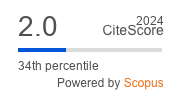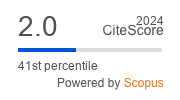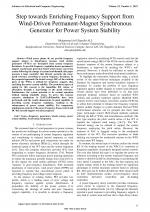| 1/2022 - 9 |
Step towards Enriching Frequency Support from Wind-Driven Permanent-Magnet Synchronous Generator for Power System StabilityALI, M. A. S. |
| Extra paper information in |
| Click to see author's profile in |
| Download PDF |
Author keywords
frequency, generators, kinetic energy, power system stability, wind energy integration
References keywords
power(29), wind(26), control(23), systems(19), frequency(19), energy(18), dfig(12), system(11), inertia(10), regulation(9)
Blue keywords are present in both the references section and the paper title.
About this article
Date of Publication: 2022-02-28
Volume 22, Issue 1, Year 2022, On page(s): 77 - 86
ISSN: 1582-7445, e-ISSN: 1844-7600
Digital Object Identifier: 10.4316/AECE.2022.01009
Web of Science Accession Number: 000762769600008
SCOPUS ID: 85126741610
Abstract
Wind power plants do not provide frequency support subject to disturbances because wind turbine generators (WTGs) are decoupled from system frequency deviations. To provide frequency regulation from a permanent-magnet synchronous generator-based wind energy conversion system following the change in system load demand, this paper presents a basic controller that directly perturbs the rotor-speed reference according to system frequency deviations. In the proposed approach, the kinetic energy (KE) of the rotating parts of the WTGs is utilized for frequency support, thus enriching the power system stability. The prominent aspect of opting for this concept is the immediate KE release or absorption through a step-change in the speed reference. Furthermore, the system proceeds to its normal operation without causing instability issues. To prove this concept, extensive simulations in MATLAB/Simulink have been performed, and the results demonstrate its good capability in providing system frequency regulation, resulting in the enhancement of power system stability. For comparison, simultaneous control of the power-frequency droop control and DC-link inertial support was also prepared. |
| References | | | Cited By «-- Click to see who has cited this paper |
| [1] M. A. S. Ali, "LMI-based state feedback control structure for resolving grid connectivity issues in DFIG-based WT systems," Eng, vol. 2, no. 4, pp. 562-591, 2021. [CrossRef] [SCOPUS Times Cited 3] [2] S. Daniar, F. Aminifar, M. R. Hesamzadeh, H. Lesani, "Optimal controlled islanding considering frequency-arresting and frequency-stabilising constraints: A graph theory-assisted approach," IET Generation, Transmission & Distribution, vol. 15, no. 14, pp. 1-17, 2021. [CrossRef] [SCOPUS Times Cited 7] [3] Q. C. Zhong, "Power-electronics-enabled autonomous power systems: Architecture and technical routes," IEEE Transactions on Industrial Electronics, vol. 64, no. 7, pp. 5907-5918, 2017. [CrossRef] [SCOPUS Times Cited 165] [4] Y. Wu, W. Yang, Y. Hu, P. Q. Dzung, "Frequency regulation at a wind farm using time-varying inertia and droop controls," IEEE Transactions on Industry Applications, vol. 55, no. 1, pp. 213-224, 2019. [CrossRef] [SCOPUS Times Cited 174] [5] Z. Wang, W. Wu, "Coordinated control method for DFIG-based wind farm to provide primary frequency regulation service," IEEE Transactions on Power Systems, vol. 33, no. 3, pp. 2644-2659, 2018. [CrossRef] [SCOPUS Times Cited 124] [6] Y. Zhang, A. M. Melin, S. M. Djouadi, M. M. Olama, K. Tomsovic, "Provision for guaranteed inertial response in diesel wind systems via model reference control," IEEE Transactions on Power Systems, vol. 33, no. 6, pp. 6557-6568, 2018. [CrossRef] [SCOPUS Times Cited 49] [7] X. Xi, H. Geng, G. Yang, S. Li, F. Gao, "Torsional oscillation damping control for DFIG-based wind farm participating in power system frequency regulation," IEEE Transactions on Industry Applications, vol. 54, no. 4, pp. 3687-3701, 2018. [CrossRef] [SCOPUS Times Cited 49] [8] X. Xi, H. Geng, G. Yang, S. Li, F. Gao, "Two-level damping control for DFIG-based wind farm providing synthetic inertial service," IEEE Transactions on Industry Applications, vol. 54, no. 2, pp. 1712-1723, 2018. [CrossRef] [SCOPUS Times Cited 33] [9] M. Raffaele, R. Silvia, M. Canevese, "Fast frequency regulation and synthetic inertia in a power system with high penetration of renewable energy sources: Optimal design of the required quantities," Sustainable Energy, Grids and Networks, vol. 24, p. 100407, 2020. [CrossRef] [SCOPUS Times Cited 23] [10] M. A. S. Ali, K. K. Mehmood, C. H. Kim, "Full operational regimes for SPMSG-based WECS using generation of active current references," International Journal of Electrical Power & Energy Systems, vol. 112, pp. 428-441, 2019. [CrossRef] [SCOPUS Times Cited 12] [11] M. A. S. Ali, K. K. Mehmood, S. Baloch, C. H. Kim, "Wind-speed estimation and sensorless control for SPMSG-based WECS using LMI-based SMC," IEEE Access, vol. 8, pp. 26524-26535, 2020. [CrossRef] [SCOPUS Times Cited 20] [12] D. Zouheyr, B. Lotfi, B. Abdelmadjid, "Improved hardware implementation of a TSR based MPPT algorithm for a low cost connected wind turbine emulator under unbalanced wind speeds," Energy, vol. 232, p. 121039, 2021. [CrossRef] [SCOPUS Times Cited 42] [13] M. A. S. Ali, K. K. Mehmood, C. H. Kim, "Power system stability improvement through the coordination of TCPS-based damping controller and power system stabilizer," Advances in Electrical and Computer Engineering, vol. 17, no. 4, pp. 27-36, 2017. [CrossRef] [Full Text] [SCOPUS Times Cited 10] [14] S. Wang, J. Hu, X. Yuan, L. Sun, "On inertial dynamics of virtual-synchronous-controlled DFIG-based wind turbines," IEEE Transactions on Energy Conversion, vol. 30, no. 4, pp. 1691-1702, 2015. [CrossRef] [SCOPUS Times Cited 232] [15] Y. Fu, Y. Wang, X. Zhang, "Integrated wind turbine controller with virtual inertia and primary frequency responses for grid dynamic frequency support," IET Renewable Power Generation, vol. 11 no. 8, pp. 1129-1137, 2017. [CrossRef] [SCOPUS Times Cited 116] [16] Y. Li, Z. Xu, J. Zhang, K. P. Wong, "Variable gain control scheme of DFIG-based wind farm for over-frequency support,". Renewable Energy, vol. 120, pp. 379-391, 2018. [CrossRef] [SCOPUS Times Cited 39] [17] Y. Li, Z. Xu, J. Zhang, K. P. Wong, "Advanced control strategies of PMSG-based wind turbines for system inertial support," IEEE Transactions on Power Systems, vol. 32, no. 4, pp. 3027-3037, 2017. [CrossRef] [SCOPUS Times Cited 231] [18] H. Ye, W. Pei, Z. Qi, "Analytical modeling of inertial and droop responses from a wind farm for short-term frequency regulation in power systems," IEEE Transactions on Power Systems, vol. 31, no. 5, pp. 3414-3423, 2016. [CrossRef] [SCOPUS Times Cited 261] [19] J. Van de Vyver, J. D. M. Kooning, B. Meersman, L. Vandevelde, T. L. Vandoorn, "Droop control as an alternative inertial response strategy for the synthetic inertia on wind turbines," IEEE Transactions on Power Systems, vol. 31, no. 2, pp. 1129-1138, 2016. [CrossRef] [SCOPUS Times Cited 367] [20] M. Kayikci, J. V. Milanovic, "Dynamic contribution of DFIG-based wind plants to system frequency disturbances," IEEE Transactions on Power Systems, vol. 24, no. 2, pp. 859-867, 2009. https:// [CrossRef] [SCOPUS Times Cited 486] [21] W. Yi, M. Jianhui, Z. Xiangyu, X. Lie, "Control of PMSG-based wind turbines for system inertial response and power oscillation damping," IEEE Transactions on Sustainable Energy, vol. 6, no. 2, pp. 565-574, 2015. [CrossRef] [SCOPUS Times Cited 344] [22] X. Zhang, X. Zha, S. Yue, Y. Chen, "A frequency regulation for wind power based on limited over-speed de-loading curve partitioning," IEEE Access, vol. 6, pp. 22938-22951, 2018. [CrossRef] [SCOPUS Times Cited 70] [23] Y. Li, Z. Xu, J. Zhang, H. Yang, K. P. Wong, "Variable utilization level scheme for load-sharing control of wind farm," IEEE Transactions on Energy Conversion, vol. 33, no. 2, pp. 856-868, 2018. [CrossRef] [SCOPUS Times Cited 28] [24] P. Li, W. Hu, R. Hu, Q. Huang, J. Yao, Z. Chen, "Strategy for wind power plant contribution to frequency control under variable wind speed," Renewable Energy, vol. 130, pp. 1226-1236, 2019. [CrossRef] [SCOPUS Times Cited 65] [25] X. Lyu, J. Zhao, Jia Y. Jia, Z. Xu, K. P. Wong, "Coordinated control strategies of PMSG-based wind turbine for smoothing power fluctuations," IEEE Transactions on Power Systems, vol. 34, no. 1, pp. 391-401, 2019. [CrossRef] [SCOPUS Times Cited 94] [26] A. Uehara, A. Pratap, T. Goya, T. Senjyu, A. Yona, N. Urasaki, T. Funabashi, "A coordinated control method to smooth wind power fluctuations of a PMSG-based WECS," IEEE Transactions on Energy Conversion, vol. 26, no. 2, pp. 550-558, 2011. [CrossRef] [SCOPUS Times Cited 322] [27] D. Gautam, L. Geol, R. Ayyanar, V. Vittal, T. Harbour, "Control strategy to mitigate the impact of reduced inertia due to doubly fed induction generators on large power systems," IEEE Transactions on Power Systems, vol. 26, no. 1, pp. 214-224, 2011. [CrossRef] [SCOPUS Times Cited 327] [28] X. Zeng, T. Liu, S. Wang, Y. Dong, Z. Chen, "Comprehensive coordinated control strategy of PMSG-based wind turbine for providing frequency regulation services," IEEE Access, vol. 7, pp. 63944-63953, 2019. [CrossRef] [SCOPUS Times Cited 64] [29] H. Shao, X. Cai, Z. Li, D. Zhou, S. Sun, L. Guo, Y. Cao, F. Rao, "Stability enhancement and direct speed control of DFIG inertia emulation control strategy," IEEE Access, vol. 7, pp. 120089-120105, 2019. [CrossRef] [SCOPUS Times Cited 44] [30] J. Zhao, X. Lyu, Y. Fu, X. Hu, F. Li, "Coordinated microgrid frequency regulation based on DFIG variable coefficient using virtual inertia and primary frequency control," IEEE Transactions on Energy Conversion, vol. 31, no. 3, pp. 833-845, 2016. [CrossRef] [SCOPUS Times Cited 207] [31] K. Visscher, S. W. H. De Haan, "Virtual synchronous machine (VSG's) for frequency stabilization in future grids with a significant share of decentralized generation," In: IET-CIRED Seminar Smart-Grid Distribution; Germany: 1-4, 2008 [32] T. Kerdphol, F. S. Rahman, M. Watanabe, et al., "Small-signal analysis of multiple virtual synchronous machines to enhance frequency stability of grid-connected high renewables," IET Generation, Transmission & Distribution, vol. 15, no. 8, pp. 1273-1289, 2021. [CrossRef] [SCOPUS Times Cited 19] [33] Q. C. Zhong, G. Weiss, "Synchronverters: inverters that mimic synchronous generators," IEEE Transactions on Industrial Electronics, vol. 58, no. 4, pp. 1259-1267, 2011. [CrossRef] [SCOPUS Times Cited 2926] [34] M. Fazeli, G. M. Asher, C. Klumpner, L. Yao, M. Bazargan, "Novel integration of wind generator-energy storage systems within microgrids," IEEE Transactions on Smart Grid, vol. 3, no. 2, pp. 728-737, 2012. [CrossRef] [SCOPUS Times Cited 67] [35] M. A. S. Ali, K. K. Mehmood, J. K. Park, C. H. Kim, "Battery energy storage system-based stabilizers for power system oscillations damping," Journal of the Korean Institute of Illuminating and Electrical Installation Engineers, vol. 10, pp. 75-84, 2016. [CrossRef] [36] J. Zhu, X. Lyu, Y. Fu, X. Hu, F. Li, "Synthetic inertia control strategy for doubly fed induction generator wind turbine generators using lithium-ion supercapacitors," IEEE Transactions on Energy Conversion, vol. 33, no. 2, pp. 773-783, 2018. [CrossRef] [SCOPUS Times Cited 114] [37] W. Xing, H. Wang, L. Lu, X. Han, K. Sun, M. Ouyang, "An adaptive virtual inertia control strategy for distributed battery energy storage system in microgrid," Energy, vol. 233, p. 121155, 2021. [CrossRef] [SCOPUS Times Cited 54] [38] M. A. S. Ali, K. K. Mehmood, J. S. Kim, C. H. Kim, "ESD-based crowbar for mitigating DC-link variations in a DFIG-based WECS," 2019 International Conference on Power Systems Transients (IPST), Perpignan, 2019, pp. 1-6 [39] Y. Zuoa, Z. Yuana, F. Sossanb, A. Zecchinoa, R. Cherkaouia, M. Paolonea, "Performance assessment of grid-forming and grid-following converter-interfaced battery energy storage systems on frequency regulation in low-inertia power grids," Sustainable Energy, Grids and Networks, vol. 27, p. 100496, 2021. [CrossRef] [SCOPUS Times Cited 100] [40] C. Parthasarathy, H. Hafezi, H. Laaksonen, "Integration and control of lithium-ion BESSs for active network management in smart grids: Sundom smart grid backup feeding case," Electrical Engineering, vol. 33, no. 6, pp. 859-867, 2021. [CrossRef] [SCOPUS Times Cited 6] [41] IEEE application guide for interconnecting distributed resources with electric power systems, IEEE Standard 1547.2TM, 2008 [42] M. A. S. Ali, K. K. Mehmood, S. Baloch, C. H. Kim, "Modified rotor-side converter control design for improving the LVRT capability of a DFIG-based WECS," Electric Power Systems Research, vol. 186, p. 106403, 2020. [CrossRef] [SCOPUS Times Cited 53] [43] M. A. S. Ali, "Utilizing active rotor-current references for smooth grid connection of a DFIG-based wind-power system," Advances in Electrical and Computer Engineering, vol. 21, no. 4, pp. 91-98, 2020. [CrossRef] [Full Text] [SCOPUS Times Cited 11] Web of Science® Citations for all references: 0 SCOPUS® Citations for all references: 7,358 TCR Web of Science® Average Citations per reference: 0 SCOPUS® Average Citations per reference: 167 ACR TCR = Total Citations for References / ACR = Average Citations per Reference We introduced in 2010 - for the first time in scientific publishing, the term "References Weight", as a quantitative indication of the quality ... Read more Citations for references updated on 2025-07-01 03:20 in 263 seconds. Note1: Web of Science® is a registered trademark of Clarivate Analytics. Note2: SCOPUS® is a registered trademark of Elsevier B.V. Disclaimer: All queries to the respective databases were made by using the DOI record of every reference (where available). Due to technical problems beyond our control, the information is not always accurate. Please use the CrossRef link to visit the respective publisher site. |
Faculty of Electrical Engineering and Computer Science
Stefan cel Mare University of Suceava, Romania
All rights reserved: Advances in Electrical and Computer Engineering is a registered trademark of the Stefan cel Mare University of Suceava. No part of this publication may be reproduced, stored in a retrieval system, photocopied, recorded or archived, without the written permission from the Editor. When authors submit their papers for publication, they agree that the copyright for their article be transferred to the Faculty of Electrical Engineering and Computer Science, Stefan cel Mare University of Suceava, Romania, if and only if the articles are accepted for publication. The copyright covers the exclusive rights to reproduce and distribute the article, including reprints and translations.
Permission for other use: The copyright owner's consent does not extend to copying for general distribution, for promotion, for creating new works, or for resale. Specific written permission must be obtained from the Editor for such copying. Direct linking to files hosted on this website is strictly prohibited.
Disclaimer: Whilst every effort is made by the publishers and editorial board to see that no inaccurate or misleading data, opinions or statements appear in this journal, they wish to make it clear that all information and opinions formulated in the articles, as well as linguistic accuracy, are the sole responsibility of the author.



